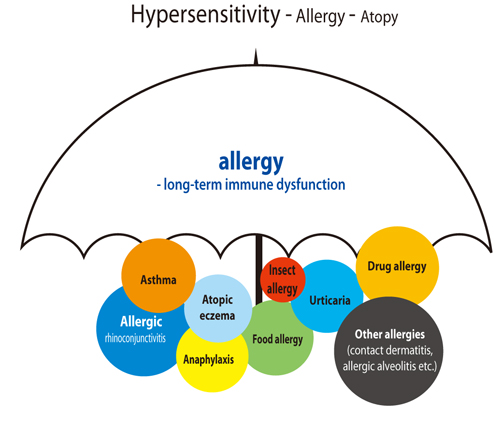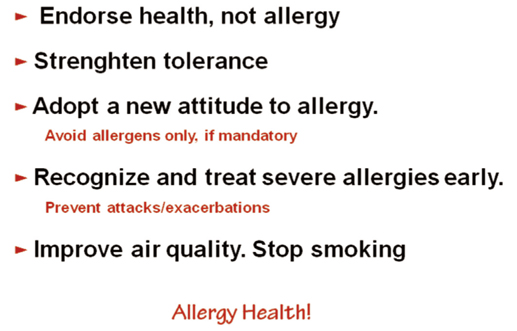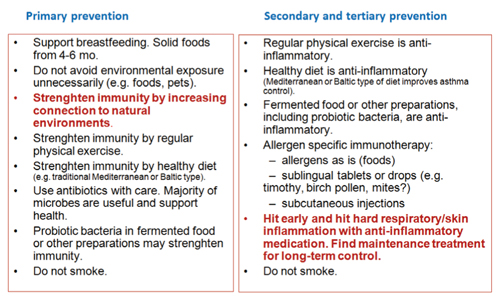Asia Pac Allergy.
2012 Oct;2(4):275-279. 10.5415/apallergy.2012.2.4.275.
The Finnish Allergy Programme 2008-2018 - scientific rationale and practical implementation
- Affiliations
-
- 1Skin and Allergy Hospital, Helsinki University Hospital, 00029 HUCH, Helsinki, Finland. tari.haahtela@hus.fi
- KMID: 2397445
- DOI: http://doi.org/10.5415/apallergy.2012.2.4.275
Abstract
- There are no nationwide, comprehensive public health programmes on allergic disorders with set goals and systematic follow-up. The Finnish initiative is based on the idea that the so called allergy epidemic in modern, urban societies is caused by inadequately developed or broken tolerance. The immune system is not trained to make the difference between danger and non-danger (allergy) or the difference between self and non-self (autoimmune diseases). The immune dysfunction leads to inappropriate inflammatory responses and clinical symptoms. The 10-year implementation programme is aimed to reduce burden of allergies both at the individual and societal levels. This is done by increasing both immunological and psychological tolerance and changing attitudes to support health instead of medicalising common and mild allergy symptoms. Severe forms of allergy are in special focus, e.g. asthma attacks are prevented proactively by improving disease control with the help of guided self-management. Networking of allergy experts with primary care doctors and nurses as well with pharmacists is the key for effective implementation. Non-governmental organizations have started a campaign to increase allergy awareness and knowledge among patients and general public. It is time to act, when allergic individuals are becoming a majority of Western populations and their numbers are in rapid increase worldwide. The first results of the Finnish Programme indicate that allergy burden can be reduced with relatively simple means.
Keyword
MeSH Terms
Figure
Cited by 2 articles
-
Implementation of guidelines, allergy programs, and the October issue
Yoon-Seok Chang
Asia Pac Allergy. 2012;2(4):231-232. doi: 10.5415/apallergy.2012.2.4.231.Asia Pacific allergy: four years of experience
Yoon-Seok Chang
Asia Pac Allergy. 2015;5(1):1-2. doi: 10.5415/apallergy.2015.5.1.1.
Reference
-
1. Laatikainen T, von Hertzen L, Koskinen JP, Mäkelä MJ, Jousilahti P, Kosunen TU, Vlasoff T, Ahlström M, Vartiainen E, Haahtela T. Allergy gap between Finnish and Russian Karelia on increase. Allergy. 2011. 66:886–892.
Article2. von Hertzen L, Hanski I, Haahtela T. Natural immunity. Biodiversity loss and inflammatory diseases are two global megatrends that might be related. EMBO Rep. 2011. 12:1089–1093.3. Hanski I, von Hertzen L, Fyhrquist N, Koskinen K, Torppa K, Laatikainen T, Karisola P, Auvinen P, Paulin L, Mäkelä MJ, Vartiainen E, Kosunen TU, Alenius H, Haahtela T. Environmental biodiversity, human microbiota, and allergy are interrelated. Proc Natl Acad Sci U S A. 2012. 109:8334–8339.
Article4. Haahtela T, von Hertzen L, Mäkelä M, Hannuksela M. Allergy Programme Working Group. Finnish Allergy Programme 2008-2018--time to act and change the course. Allergy. 2008. 63:634–645.5. von Hertzen LC, Savolainen J, Hannuksela M, Klaukka T, Lauerma A, Mäkelä MJ, Pekkanen J, Pietinalho A, Vaarala O, Valovirta E, Vartiainen E, Haahtela T. Scientific rationale for the Finnish Allergy Programme 2008-2018: emphasis on prevention and endorsing tolerance. Allergy. 2009. 64:678–701.
Article6. Pelkonen AS, Kuitunen M, Dunder T, Reijonen T, Valovirta E, Mäkelä MJ. Finnish Allergy Programme. Allergy in children: practical recommendations of the Finnish Allergy Programme 2008-2018 for prevention, diagnosis, and treatment. Pediatr Allergy Immunol. 2012. 23:103–116.
Article7. Mäkelä MJ, Pelkonen A, Valovirta E, Haahtela T. The challenge of relaying the right public health messages in allergy. Pediatr Allergy Immunol. 2012. 23:102.
Article8. Teppo H, Revonta M, Haahtela T. Allergic rhinitis and asthma have generally good outcome and little effect on quality of life - a 20-year follow-up. Allergy. 2011. 66:1123–1125.
Article9. Reitamo S, Remitz A, Haahtela T. Hit early and hit hard in atopic dermatitis and not only in asthma. Allergy. 2009. 64:503–504.
Article10. Turpeinen M, Pelkonen AS, Selroos O, Nikander K, Haahtela T. Continuous versus intermittent inhaled corticosteroid (budesonide) for mild persistent asthma in children--not too much, not too little. Thorax. 2012. 67:100–102.11. Mäkelä M, Kulmala P, Pelkonen A, Remes S, Kuitunen M. Food hyposensitization--new approach and treatment for food allergies. Duodecim. 2011. 127:1263–1271. (in Finnish).12. Kauppi P, Kämäräinen J, Haahtela T. Finnish Allergy Programme clearly necessary - training and tools needed. Suom Laakaril. 2010. 65:3515–3520. (in Finnish).13. Saarinen K. Internet-based survey among allergic people. Allerg Astma. 2011. 41:42–43. (in Finnish).14. Kauppi P, Linna M, Martikainen J, Mäkelä MJ, Haahtela T. Follow-up of the Finnish Asthma Programme 2000-2010: reduction of hospital burden needs risk group rethinking. Thorax. 2012. 04. 15. [Epub ahead of print].
Article15. Kauppi P, Linna M, Hämäläinen P, Haahtela T. Hospital treatment and emergency visits as quality indicators. Suom Laakaril. 2010. 65:3497–3502. (in Finnish).16. Pawankar R, Canonica GW, Holgate ST, Lockey RF, editors. World Allergy Organization (WAO) White Book on Allergy 2011-2020. 2011. Milwaukee: WAO.17. Boulet LP, FitzGerald JM, Levy ML, Cruz AA, Pedersen S, Haahtela T, Bateman ED. A guide to the translation of the Global Initiative for Asthma (GINA) strategy into improved care. Eur Respir J. 2012. 39:1220–1229.
Article18. Bousquet J, Anto J, Auffray C, Akdis M, Cambon-Thomsen A, Keil T, Haahtela T, Lambrecht BN, Postma DS, Sunyer J, Valenta R, Akdis CA, Annesi-Maesano I, Arno A, Bachert C, Ballester F, Basagana X, Baumgartner U, Bindslev-Jensen C, Brunekreef B, Carlsen KH, Chatzi L, Crameri R, Eveno E, Forastiere F, Garcia-Aymerich J, Guerra S, Hammad H, Heinrich J, Hirsch D, Jacquemin B, Kauffmann F, Kerkhof M, Kogevinas M, Koppelman GH, Kowalski ML, Lau S, Lodrup-Carlsen KC, Lopez-Botet M, Lotvall J, Lupinek C, Maier D, Makela MJ, Martinez FD, Mestres J, Momas I, Nawijn MC, Neubauer A, Oddie S, Palkonen S, Pin I, Pison C, Rancé F, Reitamo S, Rial-Sebbag E, Salapatas M, Siroux V, Smagghe D, Torrent M, Toskala E, van Cauwenberge P, van Oosterhout AJ, Varraso R, von Hertzen L, Wickman M, Wijmenga C, Worm M, Wright J, Zuberbier T. MeDALL (Mechanisms of the Development of ALLergy): an integrated approach from phenotypes to systems medicine. Allergy. 2011. 66:596–604.
Article19. Kupczyk M, Haahtela T, Cruz AA, Kuna P. Reduction of asthma burden is possible through National Asthma Plans. Allergy. 2010. 65:415–419.
Article20. Chung EH, Seo SH, Seo HJ, Jou HM, Kim YA, Kim YT. Prevention & control of asthma and allergic diseases in Korea. 2011. In : WAO XXII World Allergy Congress; 2011 Dec 4-8; Mexico, Cancun. Milwaukee: WAO;Abstract 4114.21. Kim YY. Past, present, and future of allergy in Korea. Allergy Asthma Immunol Res. 2010. 2:155–164.
Article
- Full Text Links
- Actions
-
Cited
- CITED
-
- Close
- Share
- Similar articles
-
- Educational and decision-support tools for asthma-management guideline implementation
- Letter to the Study by Hyvönen et al. on Moisture Damage and MCS
- Implementation of guidelines, allergy programs, and the October issue
- The Relevance of Nasal Cytology in the Workup of House Dust Mite-Induced Allergic Rhinitis
- Practical strategies for the improvement of the Korean Medical Association’s governance





